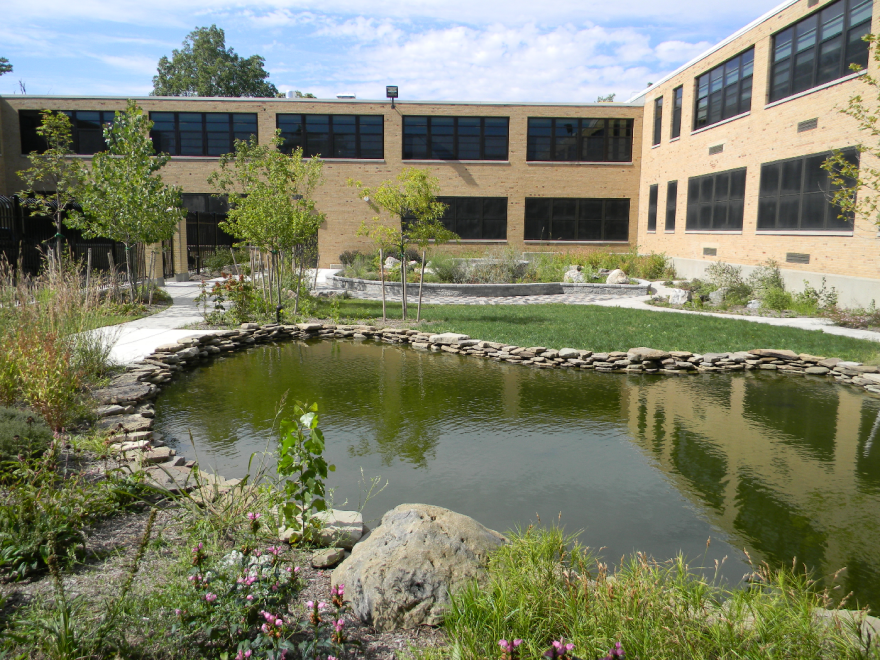Educators across the country agree schools need more students to excel in science, technology, engineering and math (STEM). Yet hooking students on these subjects remains a challenge, especially for generally low performing schools with few resources.
But this year, administrators in Buffalo Public Schools (BPS) tried to tackle the problem in a new way – by sending some of its teachers to summer school.
“I haven’t been in a lab in 43 years,” says Susan Wade, a BPS science teacher.
This summer, while Wade’s students were home, she was still in a classroom – sitting in a desk – learning new technology and teaching methods.
Wade is just one of 60 Buffalo teachers now sporting new skills, thanks to a $9.8 million grant from the National Science Foundation. The program, known as the Interdisciplinary Science and Engineering Partnership (ISEP), places teachers in contact with graduate students with the University at Buffalo and other science-based organizations.
After years of treading water professionally, Wade says the new training is better late than never.
“Our sixth grade is now being taught an hour a day of science. They used to get 20 minutes every other day,” says Wade.
This semester, the re-trained BPS teachers will take students out to local streams to collect water samples for testing in a lab, among other experiments.
“We tested Gatorade for some of the biological ions,” says Perka Kresic, a middle-school science teacher with BPS. “We’re basically targeting ion selective electrodes where the students will have a better understanding what ions are.”
These kind of hands-on assignment keeps teenage students from tuning out math and science at exactly the age when most do.
The idea: better science teachers will produce better science students.
“Kids act out for a reason”
The program trained many teachers from Public School 197, which will serve as a testing ground for its success. The six-year old school sits on Buffalo’s East Side, an area rife with crime, drugs, cyclic poverty and some of the lowest performing schools in New York.
But 197 is not your average high school – students choose between three science majors, wear uniforms and are expected to attend college.
In between classes, hundreds of students pour into the hallways and some display rowdy behavior. Despite the school’s academic rigor, Principal Rose Schneider deals constantly with low attendance and discipline problems.
“You know what? Stop! The language is ridiculous. And I have company!” Schneider bellows down the hall.
Later in her office, Schneider explains, “Kids act out for a reason. The bottom line is, we always ask, ‘Why? why? why?’ There’s [always] reasons.”
Overcoming these inherent challenges to successfully teach math and science requires more than re-training teachers.
Schneider leads me to her school’s new courtyard with a stream, pond, blueberry bushes and a pile of rocks.
“Every single rock here is a rock that students need to know in earth science,” says Schneider. “They’re out here, they’re engaged. It’s very hard sometimes to get a 16-year-old interested into science. But they’re engaged and they’re learning. And they’re able to bring all of this into the classroom.”
A visit to the courtyard is a mini field trip, without the need for permission slips. Physical science teacher Michelle Zimmermann says it’s often students’ first encounter with nature.
“They’re not used to it. Or they think it might be dirty. A lot of them have never had that experience,” says Zimmerman. “To get up close to water, to come out here and take a sampling and go into a laboratory and look at what’s in the water. So that it’s not just ‘Here’s something in a cup, look at it, see what it’s like under a microscope. They actually understand where it comes from and how it got there.”
The courtyard is just one part of a multi-million dollar renovation at PS197, now rebranded as Math, Science and Technology Preparatory School.
Schneider shows off new classrooms, several with better facilities than some universities. These investments set the stage for students to study subjects like nanotechnology.
Still, it may take a long term change of culture at the school before its potential can be realized. Every few minutes, Schneider instructs students to pull up sagging pants, remove clothing extraneous to the school’s uniform policy and to enter class on-time.
Most students are pushed by their parents to attend this challenging school, Schneider says. They dream of their children going to college and finding good jobs one day. After all, students interested in math, science and technology are more likely graduate high school and attend college.
With tens of millions of taxpayer dollars being spent on new classrooms and teacher training, now the question is, how will students respond?







